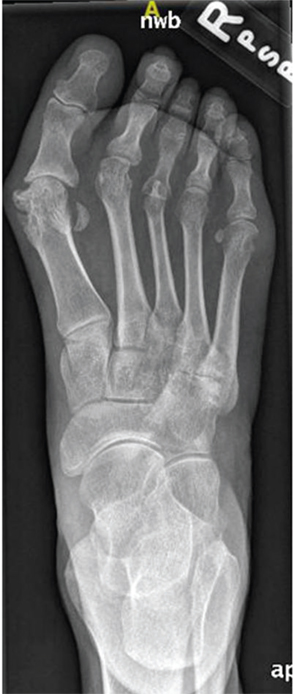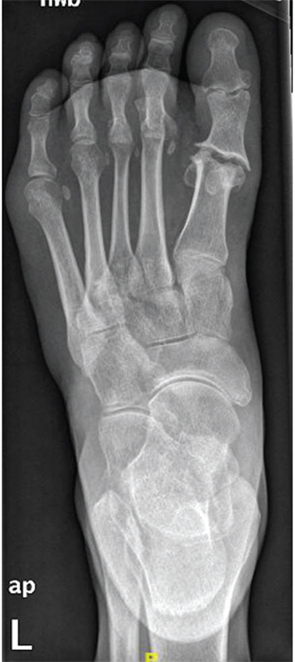Findings/Diagnosis
An anteroposterior (AP) radiograph of the right foot shows hallux valgus of the first metatarsal phalangeal (MTP) joint, erosive changes at the first and fifth metatarsal bones and degenerative changes at the fourth and fifth metatarsal-cuboid joints. An AP radiograph of the left foot shows extensive erosive and degenerative changes at the first through third MTP joints, with subluxation of the second and third proximal phalanges.
Inflammatory polyarthritis of the small joints is a common feature of SLE, but it is typically a non-erosive process. When joint deformity occurs, it is often because of laxity in periarticular tendons and ligaments. These deformities are reducible and have been described as a type of Jaccoud arthropathy (initially described by Sigismond Jaccoud as a late complication of rheumatic fever).
In the current case, evidence is present of an erosive inflammatory process, which is atypical for SLE. Additional serologic testing in this patient revealed a negative rheumatoid factor (RF) and a very high-titer anti-citrullinated peptide antibody (ACPA). Although ACPAs are present in upwards of 6–14% of patients with SLE, the erosive radiographic changes support the diagnosis of an RA and SLE overlap syndrome, sometimes termed rhupus.
The diagnosis of rhupus is one based upon clinical presentation, supportive serologies, and radiographic imaging. Previously thought to affect 1–3% of patients with SLE, a recent prospective cohort of 103 patients with SLE showed a prevalence of 9.7%.1 In that study, patients with rhupus typically had less renal disease and higher inflammatory markers compared with other lupus patients.
Treatment of rhupus often includes disease-modifying anti-rheumatic drugs (DMARDs), including biologics. In patients with SLE, use of anti-tumor necrosis factor-α agents is occasionally associated with exacerbation of symptoms, auto-antibody production and other adverse events.2
Rituximab, effective in the treatment of RA and in some patients with SLE, has effectively improved disease activity, functional outcomes and serologic markers in a study of six patients with rhupus who had been unresponsive to other DMARDs.3
In the case presented here, the patient’s inflammatory arthritis did not respond to multiple DMARDs: hydroxychloroquine, methotrexate, azathioprine or mycophenolate mofetil. Rituximab was initially effective, but later associated with hypersensitivity vasculitis. Etanercept caused an exacerbation of skin disease. After starting intravenous belimumab, the patient has had sustained improvement in inflammatory arthritis and cutaneous lupus disease activity.

Figure 1: Anteroposterior (AP)
radiograph of the left foot.

Figure 2: AP radiograph of the left foot.
Cianna Leatherwood, MD, is a rheumatology fellow at Brigham and Women’s Hospital in Boston. Clinical and research interests include SLE and healthcare disparities.
Derrick J. Todd, MD, PhD, is a staff rheumatologist at Brigham and Women’s Hospital in Boston, and director of the Brigham and Women’s Rheumatology Musculoskeletal Ultrasound Center. Areas of clinical expertise include MSK ultrasound and adolescent rheumatology for patients transitioning from pediatric to adult rheumatology care.
Send us your images
Contact us at:
Simon Helfgott, MD, physician editor
E-mail: [email protected]
Keri Losavio, editor
E-mail: [email protected]
References
- Tani C, D’Aniello D, Delle Sedie A, et al. Rhupus syndrome: Assessment of its prevalence and its clinical and instrumental characteristics in a prospective cohort of 103 SLE patients. Autoimmun Rev. 2013 Feb;12(4):537–541. doi: 10.1016/j.autrev.2012.09.004. Epub 2012 Oct 11. PubMed PMID: 23063507.
- Katz U, Zandman-Goddard G. Drug-induced lupus: An update. Autoimmun Rev. 2010 Nov;10(1):46–50. doi: 10.1016/j.autrev.2010.07.005. Epub 2010 Jul 23. Review. PubMed PMID: 20656071.
- Piga M, Gabba A, Cauli A, et al. Rituximab treatment for ‘rhupus syndrome’: Clinical and power-Doppler ultrasonographic monitoring of response. A longitudinal pilot study. Lupus. 2013 May;22(6):624–628. doi: 10.1177/0961203313482741. Epub 2013 Apr 4. PubMed PMID: 23559669.
